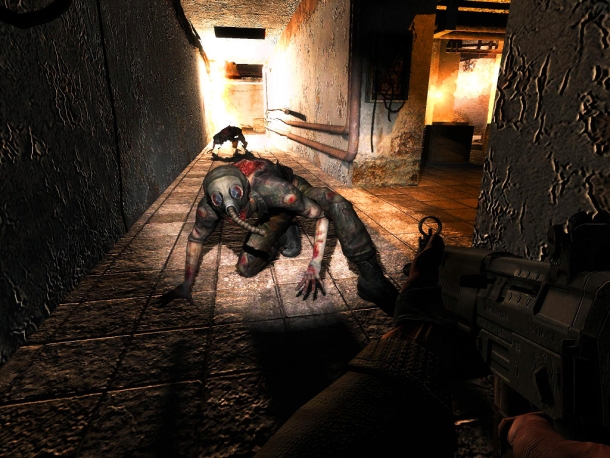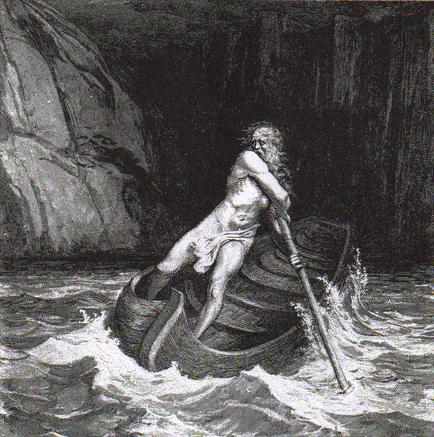For Neocore, the literature it's chosen to adapt is really about character. "The core personalities remain intact. In King Arthur, the Knights of the Round Table are more like supernatural heroes, who can fight and cast spells. Sir Lancelot can also cast spells and use unique abilities, but he is the same noble, somewhat aggressive, rightful champion we've known, while Mordred is the same villain who can cause the fall of an empire."
Character-centered stories pose great challenges for game designers, even when those stories are original. Taking someone else's story and making it your own presents the problem of staying faithful to the original source but still making the game an original experience. Knight points to how Dante's development team used the poet's own criteria for deciding which historical figures should be used to fill out Hell.
Noting that Dante's Hell is populated by "only Greek and Roman heroes or 13th-century Florentines," Knight insists that the underpopulated circles of Hell, like Greed (where infamous traitor Tarpeia and others were inserted), have the same focus. For Dante, the choice of characters reflects a connection between the classical virtues and vices and those of his own time. EA didn't want to lose that connection, even though they had a thousand years of villains to draw from.

One of the Witcher novels...
But when you're dealing with a lead character from one of your nation's most popular fantasy sagas, you're very limited in what you can and cannot do. "The Witcher" novels are to Poland what the "Wheel of Time" or "Song of Ice and Fire" series are to the English-speaking world. A sprawling epic that has only rarely been translated out of its native tongue, it is only familiar to us in America through CD Projekt's role-playing game. Like the books, the game is full of sex and violence, but these have never really been a challenge for game designers. Artur Ganszyniec -- lead story designer for the "Witcher" videogame adaptation -- was dealing with a beloved story, and characters that a generation of Poles are familiar with.
"The influence of the books cannot be overestimated. Geralt of Rivia was created almost 25 years ago, so there is a whole generation of players in Poland raised on Sapkowski's stories," he explains. "We read them at the high school and later over the years, as the next books of the saga were published. You can imagine the pressure we had while working on the game. People expected a lot, and some fans were really skeptical, as there already was a movie adaptation of the books and it was definitely not a hit."
As with EA and "Dante's Inferno," Ganszyniec's team faced the problem of integrating characters from well-known stories into something original. "We introduced some characters from the books, tried to use the same archetypes and motifs. We discussed a lot about how the characters were built in books and how to use the techniques in-game. All in all, it was a creative adaptation -- translating the world and feel of the narrative into a very different medium."

...and the game based on it.
Inspiration vs. Adaptation
Given the relatively small size of the Polish market, CD Projekt could have made more changes to the game setting and tone without necessarily alienating the broader game market. But this was never really considered -- the developer worked around the novels in many ways, filling gaps in the stories that Sapkowski told and adapting the dialog to fit what readers had come to expect of the world.
The developers of S.T.A.L.K.E.R., however, moved in a very different direction. Though inspired by "Roadside Picnic" -- a celebrated 1970s science-fiction tale by Arkady and Boris Strugatsky -- Oleg Yarovsky and his colleagues at GSC Gameworld decided to set their game in a more immediate world, with a terror they were more familiar with. It is S.T.A.L.K.E.R. that most closely approximates Knight's ideal of an original take on another author's idea.
"We deliberately wanted to keep out of any extraterrestrial involvement into the Zone (as the book stipulates) in favor of the grim reality of Chernobyl, which we simply find more interesting and, in the long run, more scary. The invisible radiation threat, ruins of Soviet empire plentiful -- going to Chernobyl is spooky," says Yarovsky. "Due to facts and evidence of the 1986 accident largely concealed by the USSR government, we could build our own conspiracy theories about experiments on psychotropic weapons and such in the game's story. We had wanted to make a game set in Chernobyl, but it was only with S.T.A.L.K.E.R. that we felt it was the right concept."

S.T.A.L.K.E.R. -- creepy!
So why bother with S.T.A.L.K.E.R. at all? Why not just create a new Chernobyl-themed shooter? "What we liked about the book and movie was the idea of stalkerism -- a loner scavenging the danger zone that risks his life for cash -- and this is what makes the story and the game alike." The new S.T.A.L.K.E.R. world has been successful enough to launch its own series of novels, not yet available in English.
Like EA's Dante's Inferno, S.T.A.L.K.E.R. changes the time and plot of the story, but clings to what is seen as a common element in the parallel worlds. S.T.A.L.K.E.R. is clearly more in line with what we see as an original take on another story, however. Where the Strugatsky brothers' novella posited a world devastated by alien interference, GSC reminds us that the world can be devastated by human means, and that some parts of the world were only minutes away from a very bleak future. "Stalkerism" is survivalism, a theme embraced by games like Fallout, another admitted inspiration for S.T.A.L.K.E.R.. This isn't turning "Pride and Prejudice" into a zombie novel; it's turning "Emma" into "Clueless" -- a new setting that touches many of the same important themes.
Some lines won't be crossed for reasons of integrity, and this is the difference between inspiration and adaptation. Though some purists might blanch at the idea of a topless Beatrice, Knight emphasizes that he had to insist that other hellish mythologies not contaminate what was going on in Dante's world. You won't find infernal legions akin to those in Milton's "Paradise Lost" (an inspiration for last year's indie game Solium Infernum) and no imagery from the End Times or Revelations. "If it didn't feel medieval, I didn't want to do it," Knight says. Since Dante's Hell was the original idea for the setting, the game itself must be faithful to that Hell -- a deeply personal place where the game's hero must face his own sins while saving his beloved.
When Visions Collide
Knight somewhat approvingly points to Walt Disney's insistence that people making the animated "Jungle Book" needed to know little about Kipling's original story. Of course, just as MGM's "The Wizard of Oz" overshadows Baum's book in the popular imagination, Disney's Mowgli and Baloo have a greater recognition factor than the characters in the novel (and you can say the same of Disney's "Winnie-the-Pooh," "Snow White," "Little Mermaid" ... heck, any source the Mouse touches). Though Knight quotes teachers who applaud the idea that their students might pick up "The Divine Comedy," one wonders what, exactly, these students expect when the new Random House edition of "Inferno" has the game's hero on the cover with a monster scythe -- something you will find nowhere in the poem, of course.
Games are, as yet, nowhere near a universal cultural medium whose images and ideas can transform decades or centuries of received wisdom. The mixed critical response to EA's Dante's Inferno further ensures that, even if they do move on to the less dramatic "Purgatorio," this adaptation has little chance of displacing a poem whose imagery has stood the test of time and continuous re-imagining. Dante's poem is so vivid, so powerful, that EA's work will probably stand beside American McGee's Alice as a game that brought glorious descriptions to life, but still pales alongside the original. As creatively exciting as EA's Charon is -- a being that is part man and part boat -- the spectral figure beckoning Virgil and the poet to board his raft is so powerful that even the game industry's equivalent of Disney can't eclipse him.

Charon -- also creepy.
The question remains, though, of whether a bloody action game is the best way to translate Dante's Hell. An adventure game would have been more faithful, obviously... though Knight understandably says he didn't want gamers crawling around and solving a mud puzzle in order to get past Cerberus. Game developers have already demonstrated that they can tell powerful original stories surrounded by action.
Epic poems are not action games, but medieval sagas are not strategy games, either. Game designers are working within the genres they know to translate a medium with its own genres and conventions. To casual observers, some of these games might look like distortion of authorial intent at best, heretical abominations at worst. However, many game developers take the question of adaptation seriously. Driven by a desire to bring beloved characters or themes to life, these developers understand that the texts they touch have an audience that preceded theirs. We'll certainly see poor adaptations, and probably a bastardization or two. Still, if games can move beyond their motion-picture inspirations, chance are that future literary games will need to look less like movies.
Troy Goodfellow is a freelance writer based in Maryland. He blogs about strategy games at Flash of Steel and hosts Three Moves Ahead, a weekly podcast about the same topic.


